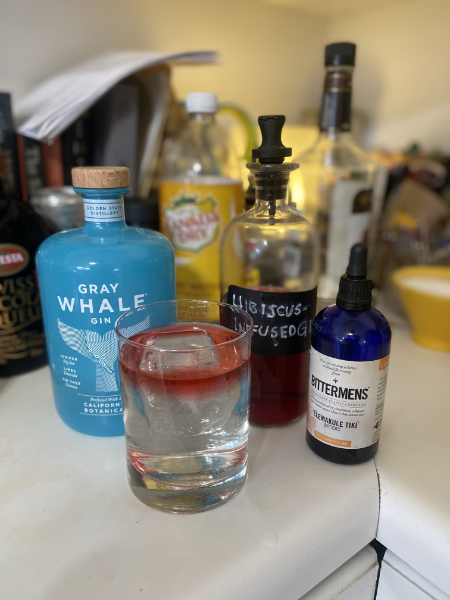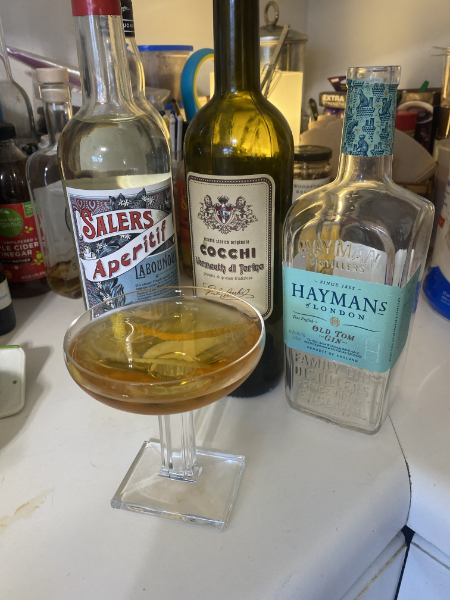If you’re into craft cocktails at all, you know that green Chartreuse vanished during the pandemic and is now slowly returning to the shelves, albeit at horrendous prices. It seems that the Carthusian monastery that has made it since 1737 had a literal come-to-Jesus meeting and decided that they would dial back their commitment to supplying the world with one of its essential liqueurs. Ergo, supply < demand = higher prices. Like $100/bottle prices.
Naturally, our brave bartenders and cocktail writers have been feverishly writing articles about the Next Best Substitute for green and yellow Chartreuse. In my bar I already had Boomsma Cloosterbitter, and on a recent jaunt to Little Five Points in Atlanta I popped into the package store there and was stunned to see the Faccia Brutto Centerbe — I had heard that it was as hard to find as the real stuff.
So the other night I had a direct taste test, making a small Bijou[1] out of each one.

How small? I used only .25 oz of each ingredient — no way was I going to either 1) drink three full Bijous; or 2) pour out a drink containing green Chartreuse, what, are you crazy??
Above you see a quarter-ounce of each liqueur: Centerbe, Cloosterbitter, and Chartreuse. The Cloosterbitter is actually a little greener than the Chartreuse. Flavorwise, Centerbe and Cloosterbitter are very similar to Chartreuse. There are subtle differences, but on the whole I think we’ll be fine using the other two in most cocktails calling for Chartreuse.

Here are the three mini-Bijous, identical in appearance, and again, pretty much the same in taste. There were very subtle differences, but my palate is not that refined (nor am I that driven) that I’m going to nail those differences down when all three cocktails were perfectly yummy. If I handed you the Centerbe or Cloosterbitter version, you wouldn’t know it if I didn’t tell you.
Last night I tried my own Smoky Topaz: 1.5 oz barrel-aged gin (Tom Cat preferred), .75 oz yellow Chartreuse, .25 oz green Chartreuse (Cloosterbitter this time), .75 oz Averna Amaro.

Again, as tasty as with actual green Chartreuse.
But you have already spotted a weakness in my plan: All this time I’ve been hoarding green Chartreuse without giving a thought to the yellow… and now I’m about to be out of yellow Chartreuse with no backup.
More work is required.
—————
[1] Bijou: 3/4 oz each of gin (I prefer barrel-aged for the Bijou), sweet vermouth, and green Chartreuse






 First of all, it should clearly be a Manhattan in a nod to the present indictment, and let’s add to that a praline liqueur both as a sweetener and as a nod to a possible future indictment, let’s say in Atlanta. A dash of black walnut bitters and a square of bourbon dark chocolate on the side pairs well as the dark and bitter theme, and we have a tasty tasty refreshment with which to end the week.
First of all, it should clearly be a Manhattan in a nod to the present indictment, and let’s add to that a praline liqueur both as a sweetener and as a nod to a possible future indictment, let’s say in Atlanta. A dash of black walnut bitters and a square of bourbon dark chocolate on the side pairs well as the dark and bitter theme, and we have a tasty tasty refreshment with which to end the week. The bottle in question is a concoction called Nixta, made in Mexico from an ancient strain of maize.
The bottle in question is a concoction called Nixta, made in Mexico from an ancient strain of maize.


 I opened the Savoy Cocktail Book randomly and there was the White Lily Cocktail. Wow, I thought, there is no way that this is going to be palatable. Rum + gin? And a dash of absinthe?
I opened the Savoy Cocktail Book randomly and there was the White Lily Cocktail. Wow, I thought, there is no way that this is going to be palatable. Rum + gin? And a dash of absinthe?
 Salers is unusual for the GUVCH since it is a clear aperitif, while most amari that I have are darker.
Salers is unusual for the GUVCH since it is a clear aperitif, while most amari that I have are darker.